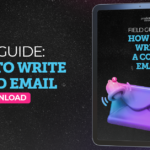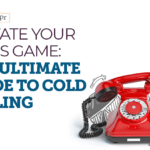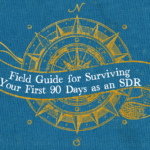Field Guide: How to write an email

Welcome to the no-fluff, straight-to-the-point guide on mastering outbound sales development. Look, there’s a sea of advice, some good, some bad, and some downright confusing. This guide cuts through the noise to bring you practical strategies and tactics.
As you flip through these pages, you won’t find vague generalizations. Instead, you’ll get down to the nuts and bolts of outreach styles, from high-volume blitzes to strategic account-based plays. You’ll get the low-down on writing email copy that doesn’t just land in an inbox but also provokes a click, a read, and a reply.
Whether you’re a battle-hardened SDR looking for an edge or a sales leader determined to elevate your entire team, you have the right playbook. So, forget what you think you know about outbound sales, and let’s set a new standard of excellence together.
Ps. This is the guide we created for our SDRs and SDR Managers.
Sequence Style
Context is king, so before you start writing an email, you need to consider the context of the sequence. Is this a fully automated email sequence, somewhat personalized, or bespoke?
Determining your Style is not a fashion choice; it results from a decision between efficiency and effectiveness. It requires considering your desired cost to acquire a customer (CAC), the size of your market (number of companies and contacts), and deciding whether to optimize for speed or conversion rate.
The determining factor here is how much time I want an SDR to invest in attempting to convert a single account. If you choose a volume approach, you’ll be able to reach many prospects very quickly with a relatively small team.
On the other end of the spectrum, approaching the same market with an Account Based Style will deliver a much higher conversion rate but requires a more experienced SDR, more supporting resources (ABM campaigns, tooling, training, etc.), and will cost more.

You can use this math for each Hypothesis to determine what sales development approach will give you the results you’re looking for.
For simplicity’s sake, we have segmented the types of approaches into four styles. Those are: volume, personalization at scale, individual personalization, and account-based. Your outreach can exist on a sliding scale between the buckets. You also don’t have to commit to just one style at a time – but more on that later.
Preface to the styles: List vs. Account-Based
We see a lot of variety in SDRs working Lists vs. being given a list of Accounts, and there is no right or wrong answer. List-based is faster to implement, but Account-Based will have a better conversion rate; you can decide which is right for you now and can always change later.
Many new sales development teams start with List-Based and then transition to Account-Based when they have more than a few reps. Let’s talk a little about each to help you understand their advantages.
A List-Based approach is any method of list building where you are not starting with a given set of accounts. This approach is best for large, wide-open markets, and quotas will be higher.
With account-based workflows, leadership decides ‘the list’ of accounts representing your TAM and assigns an SDR a subset of them to work. The SDR is then given the flexibility to find the best way into the organization. This approach is best for companies with smaller markets and larger deal sizes because the conversion rate will be the most important metric.
Volume
The volume style is all about bang for your buck. You want to spend as little to generate as many opportunities as possible. You must leverage technology as much as possible to scale your outreach. The team structure needed to do that will depend on your channel.
Channel(s): either 100% email or 100% phone.
Personalization at Scale
This style is all about leveraging targeting to make generally written messaging seem like it was written specifically for one person. Building on the Hypothesis example from above, we add an extra filter criterion that is relevant to the buyer.
When niching down like this, the question to ask yourself is, how does the context my buyer lives in change when I change one of these variables? A common example is geography. Does a VP of Sales from SF have different demand gen needs from one in LA?
It might not seem like much at first glance, but let’s consider that SF is the world’s startup capital; it has the shortest average tenure of an SDR and the highest average cost of an SDR.
Incorporating this context is a great way to write messaging you can send to a small group of prospects that will feel like it was written just for them.
Channels(s): Email, phone, and social. A phone is a non-blocking activity geared toward calling on prospects engaged with your email.
Individual Personalization
This is when you’re researching and writing at least one piece of custom messaging for each prospect. A general rule is that 20% of your email copy should be personalized. You might do this for every email you send or just for your first email.
Channel(s): A mix of email, phone, and social. The phone is used as a blocking activity and incorporated into the steps of a sequence.
ABM Supported
This is when you’re getting ABM support from your demand generation organization. Campaigns are built off of internally created intent data.
Channel(s): Builds on the above Styles and incorporates intent data or signals from an ABM campaign as a starting point.
Parts of an email
1. The Subject Line: Your First Impression
The goal of the subject line is to entice people to open your email. To achieve this, it’s crucial to ensure that your subject line and the value proposition in the body of the email align perfectly. Think of your subject line as a movie trailer; it should provide a glimpse of what’s inside, making the recipient curious enough to delve deeper.
Personalization can be a powerful tool in this context. Instead of the overused “first name + X” format, strive to understand what the recipient genuinely cares about, whether it’s their industry nuances, recent milestones, or challenges they’re grappling with.
It’s essential to maintain honesty and not resort to clickbait tactics. While they might lead to an initial opening, they won’t foster trust. Your subject line should be concise, compelling, and cut straight to the value proposition.
2. The Body Copy: Making the Connection
The body of the email should help recipients understand its relevance to them. Begin by clearly introducing yourself and the reason for your outreach. The content should resonate with the recipient, addressing their specific pain points or aspirations. Highlight how your solution or proposition can be a game-changer for them, helping them navigate challenges or seize new opportunities. It’s vital to underscore the benefits they’d reap by responding to your email, be it a unique solution, growth opportunity, or a fresh perspective.
3. The Call-To-Action (CTA): Seal the Deal
The CTA is the culmination of your email, prompting the recipient to take the desired action. Whether you’re inviting them for a call, urging a response, or directing them to a resource, the CTA should be lucid and unmistakable. While the ideal cold email would seamlessly weave the introduction, relevance, and action into a single sentence, it’s more realistic to aim for a succinct 2-3 sentences that encapsulate these elements.
Styles
Relevance
The Relevance style of cold emailing involves sharing insightful content and then probing if the problem discussed is pertinent to the recipient at that moment. This style draws inspiration from the chains of relevance, ensuring that the content resonates with the recipient’s current challenges or aspirations. Here are some examples:
V1
We have a <solution> that will accomplish your <goal>. Are you trying to get <job to be done> and facing <obstacle>?
V2
We accomplish your <goal> with a <solution>. Are you trying to <get job to be done> and facing <obstacle>?
V3
We help your <persona> overcome <obstacle> with <solution>. Are you trying to accomplish <goal> by getting <job to be done>?
V4
Are you trying to accomplish <goal> and surprised the thing getting in the way is <obstacle>? We help your <persona> who are trying to <get to be done> with <solution>.
V5
As a {{title}} at {{company}}, are you responsible for MQL creation for your team?
V5 extended
As a {{title}} at {{company}}, are you responsible for MQL creation for your team?
We help <your target audience> <list core benefits here>.
Worth a chat?
Referral
The Referral style is laser-focused on individuals adjacent to your primary buyer. The objective is to get them to refer you to someone else or identify as the person you need to talk to. Here are some examples:
Simple
Sorry to bother you, would you mind pointing me in the direction of the person responsible for <outcome> at <company>?
Extra context
Sorry to bother you, would you mind pointing me in the direction of the person responsible for <outcome> at <company>?
For context, we help companies like <customer 1 and 2> with <value prop>.
The Garrison
The Garrison style is all about leading with the benefit and directly inquiring about its relevance. It’s succinct and to the point, asking the recipient plainly if they require what you’re offering. Here are some examples:
Simple
As a {{title}} at {{company}}, are you responsible for revenue generation for your team?
We help <your target audience> <list core benefits here>.
Worth a chat?
Extra context
As a {{title}} at {{company}}, are you responsible for revenue generation for your team?
We help <your target audience> <list core benefits here>.
Could we <trial/demo offer> to show you how we can help {{Company}} achieve <value proposition 1> and <value proposition 2>?
Hiring trigger
The Hiring Trigger style operates on the assumption that a prospect, due to their new job role, might be experiencing certain challenges. The email then offers solutions to these anticipated challenges. Here are some examples:
Simple
Congrats on the role at {{company}}! With the recent change, how is {{company}} planning on <outcome>?
<list 3 customers> have been able to <outcome they accomplished>.
Worth a chat?
Extended
Congrats on the role at {{company}}! With the recent change, how is {{company}} planning on <outcome>?
<list 3 customers> have been able to <outcome they accomplished>.
<insert your company name> allows you to <describe your top value proposition>.
Is that relevant to you right now?
Follow-Up Style: Extra Context
This email will gives the reader some additional context to your first email. Making them a good one, two punch.
V1
<customer> reduced their team’s expenses by <x>% after partnering with <Company name>.
We’ve <outcome we’ve accomplished> so <titles> can focus on top-level priorities.
How are you currently navigating these challenges?
V2
In your role overseeing < customer’s role> are you looking for ways to <customer’s value prop>?
With <company>, you can <value proposition>.
Is that worth a conversation?
Follow-Up Style: Bumper
The aim of this email is to redirect the prospect’s attention to the initial email. They are brief and add very little to the conversation. Keep these to maximum one per sequence.
The shortest
Thoughts?
Emojis!!!
Just checking in again.
Can you give me a thumbs up (👍) or thumbs down (👍) on whether you are interested or not?
🤙
I sent you an email a few days ago. Just saw your profile on LinkedIn and it reminded me to reach out.
Could I get your feedback on the note below?
2nd shortest
Did you see my last email?
Follow-Up Style: Breakup
This is a final attempt to engage with a prospect who has been unresponsive, with the hope of receiving a response given that it’s sent when the likelihood of conversion is significantly diminished
Still a priority?
I reached out about the <job to be done that we solve> to see if <our solution> could be helpful.
Is this a priority?
I’ll get back to you later
Since I have not heard from you in a while, I am assuming that <service> is not a priority for you right now. It is understandable, and I don’t want to disturb you.
I will get in touch with you in 6 months and see if you like to talk about it.
Insightful question
I heard that your company has launched <new service/product>.
How has the experience been so far? I would be delighted to hear more about it.

Recent Guide
-
Field Guide: How to write an email
October 20, 2023 -
Elevate Your Sales Game: The Ultimate Guide to Cold Calling
September 18, 2023 -
Field Guide: Surviving Your First 90 Days as an SDR
March 30, 2023 -
The Ultimate Guide to Sales Coaching
May 6, 2022 -
The Ultimate Guide to Sales Development
March 10, 2022




